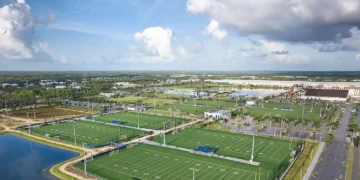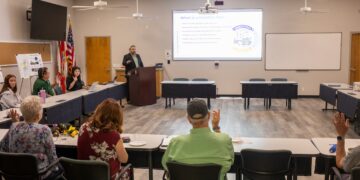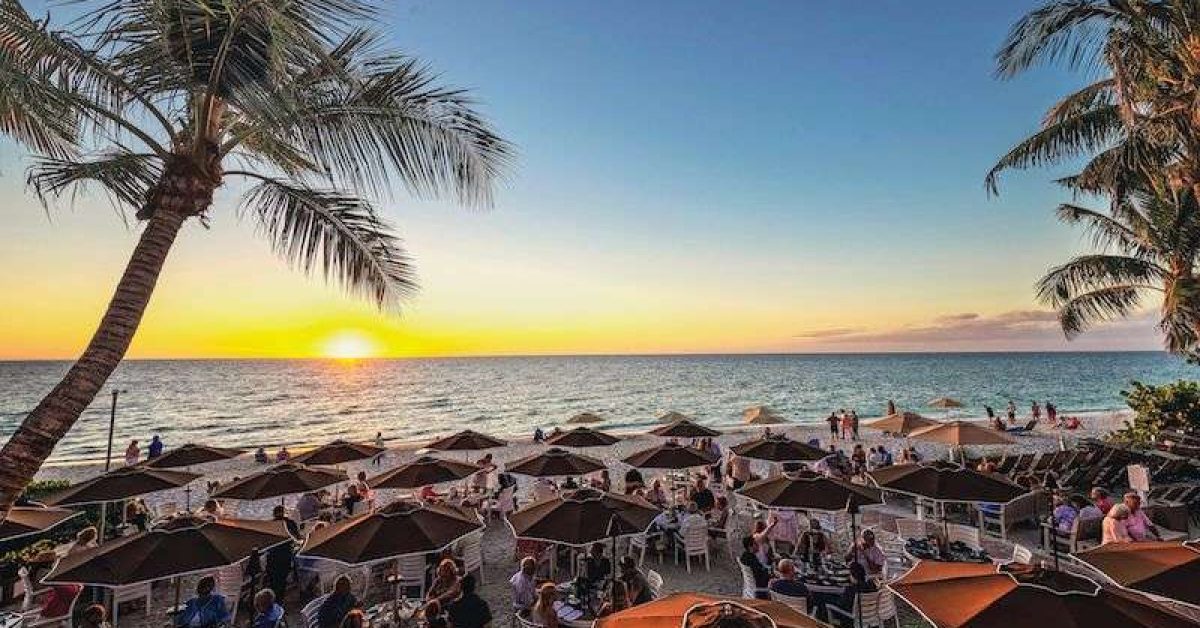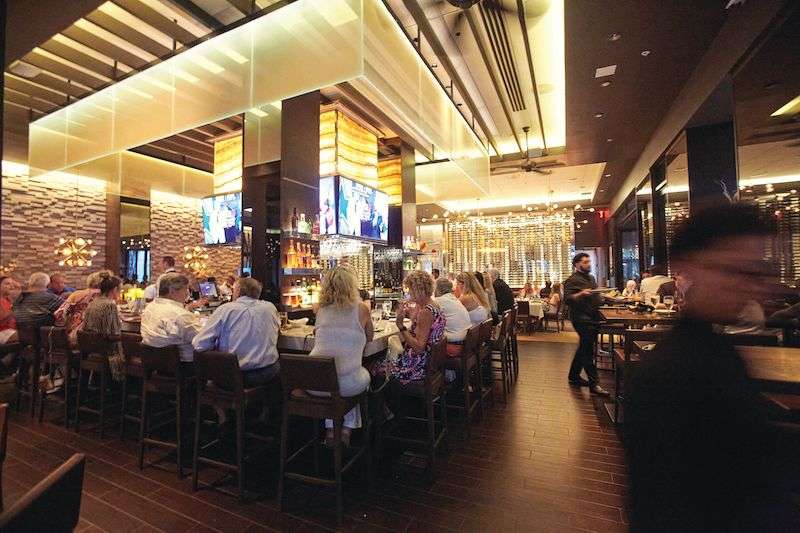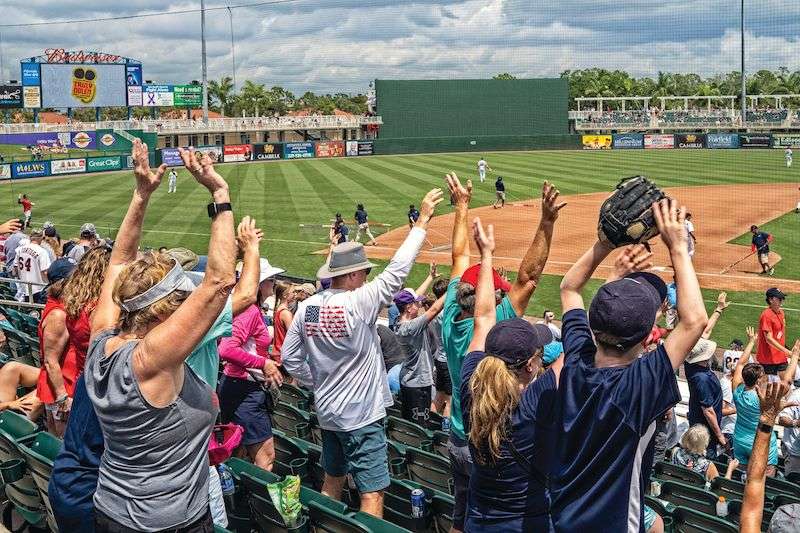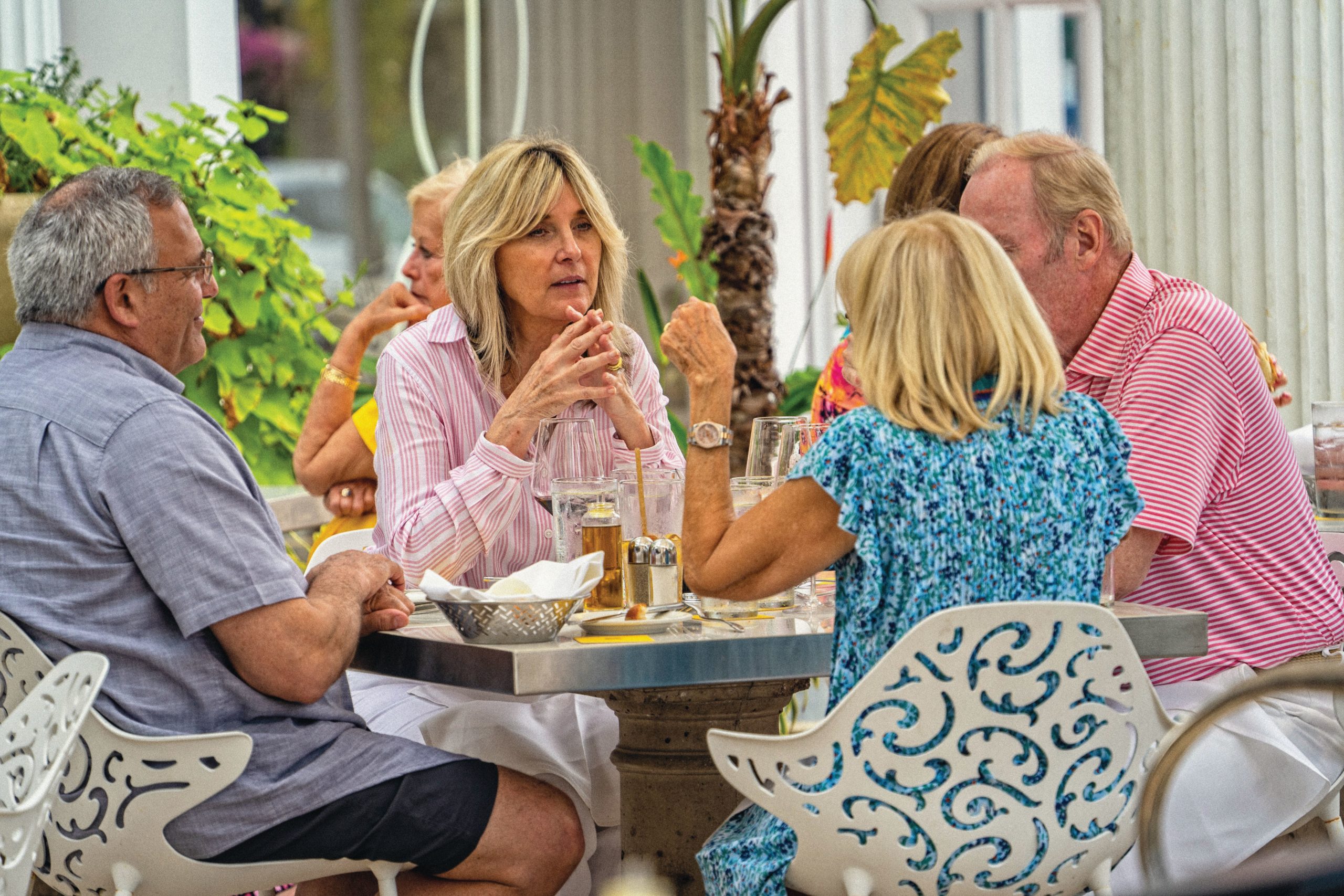Alan Adler likes vacationing on Fort Myers Beach so much that he practically lives there. The retired dentist from Michigan spends months at a time staying at the Bay Inn at the Lani Kai. When he wants a change of scenery, he packs up his stuff, loads it into his travel van and departs—venturing all of 500 feet west to the Silver Sands Villas.
Adler is approaching his 69th birthday and his seventh year of living this kind of vagabond lifestyle. As the weather grows warmer and wetter, he’ll make his way north again, migrating little by little back to his native Michigan. And as the calendar gets closer to turning, he’ll get closer to turning the van around and driving back to the beach.
Adler, as much as the numbers and statistics gathered for this year’s look back at the 2022 peak season, bears witness to the bullish market of tourism in Southwest Florida.
“I hit the road in a travel van six years ago,” he says. “I did two laps around the country. A lot of places, I’d stay one day. Whenever December rolled around, I’d get into South Florida. I didn’t want to keep moving anymore. Every year, I added more and more time on Fort Myers Beach.”
Adler’s far from alone. Not just Fort Myers Beach, but tourism across all parts of Lee, Collier and Charlotte counties has been surging. It has been on the upswing since the hotels, bars and restaurants reopened a few weeks after the threat of COVID-19 shut their doors March 17, 2020.
But the 2022 peak tourist season of January through March tells the tale of a full rebound.
Southwest Florida International Airport eclipsed 1 million passengers in January, February, March and April, a milestone it typically only reached during the month of March.
With 1.5 million passengers passing through in March, the airport broke a record for most monthly passengers. Although the omicron variant knocked back travel in mild fashion in January, the airport still drew a million passengers, the third-best January on record. Over the first three months of this year, RSW drew a combined 3,708,480 passengers, a record for January-March that was 1.6% better than the prior mark of 3,649,741 passengers set during pre-pandemic 2019.
In April, 1.2 million passengers passed through RSW, the biggest April on record. The first four months saw passenger traffic increase by 34% from last year.
The influx of visitors has translated to booming metrics that measure tourism all around the region. Occupancy rates and average daily rates help tell the tale of tourism: In Collier County, hotels achieved occupancy rates of 67%, 78% and 78% in January, February and March, respectively. That was up 1.6% in January, up 13% in February and down 3.7% in March. The average daily rate grew by 39%, 43% and 28% during those three months when compared to 2021. The daily rates stood at $493 by the end of March, according to statistics gathered by Collier County’s Paradise Coast visitor and convention bureau.
“Going into 2019, we were setting all new benchmarks,” says Paul Beirnes, executive director of Collier County’s tourism. “Everyone was celebrating numbers they’ve never seen historically. Occupancy. Average daily rate. Length of stay. All of the above. In 2020, everybody in the whole world took a bit of a hit. We started getting our foothold, very strong, in the middle of 2020 by tapping into Florida residents. The state was open by about July. Florida residents started exploring in their own backyards.”
The new Florida visitors combined with the rest of the country and the world beginning to travel again entering 2021. This set the stage for a rejuvenated tourist season in 2022, the metrics and anecdotal evidence show.
In Charlotte County, January hotel occupancy increased by 24% from 2021 to 73% this year. The average daily rate climbed by 48% to $132.65 per night. February hotel occupancy increased by 29% to 85% this year. The average daily rate grew even more, by 56%, to $187.70 per night.
Charlotte County bed tax revenue grew by 51% from January 2021 to $962,615 in 2022. It grew by 55% from February 2021 to $983,015 in 2022. It grew by 38% from March 2021 to $1.3 million in 2022.
In Lee County, hotels achieved occupancy rates of 76% in January and 88% in February. That increased by 38% in January and 29% in February from one year prior. The average daily rate grew by 37% in January to $199 and increased by 45% in February, up to $277 that month. Bed tax revenues responded by surging in Lee County. They increased by 47% to $7.79 million in January and by 44% to $8.1 million in February, as compared to a year earlier. In March, Lee County set more tourist records. The tourist tax revenue jumped from $8.7 million in March 2021 to $10.9 million this year, a record high for any month on record. It was even higher than the $9.1 million collected in each of March 2018 and 2019.
Since February of 2021, each month has set a new revenue record for that month. In Lee County, those tourist tax revenues go toward paying for sports facilities used by the Boston Red Sox and Minnesota Twins, renourishing the beaches and funding the Lee County Visitor and Convention Bureau’s 33-member staff.
NEW LOOK IN LEE
Lee County also spent $200,000 from that budget on rebranding its tourism slogan. The signage and logo shifted this year from “The Beaches of Fort Myers and Sanibel” to “Fort Myers Islands Beaches & Neighborhoods.”
Tamara Pigott, executive director of the Lee County Visitor & Convention Bureau, declined an interview request through Lee County communications director Betsy Clayton. She suggested instead talking to Lee County Commissioner Cecil Pendergrass, the chair of the Tourist Development Council.
“People keep coming here for the three W’s,” Pendergrass says, “the warmth, the weather, the water. The way of life is more casual here than on the east coast. And we have such a diverse area here to vacation.”
It’s more than about the beaches and the baseball these days, Pendergrass said. There’s ecotourism inland and activities like horseback riding in Alva. “Some people come here for shopping or golf or pickleball,” he says.
As for the rebranding, that made sense, too, he said. They wanted to get away from marketing “Lee County” to avoid confusion with the nation’s six other Lee counties.
“Fort Myers is the hub of the county,” Pendergrass says.
BEACH HOTELS FULL
Adler, the vagabond tourist, has plenty of company at the Lani Kai, where tourist season seems to never end, said Melissa Schneider, the hotel’s marketing director.
In January, the Lani Kai’s 100 rooms have gone from 94% occupied in pre-pandemic 2018 to 96% this year. In February, the Lani Kai surged from 96% in 2018 to 100% occupancy this year. In March, more of the same: 100% this year. In April, the hotel experienced 100% occupancy in 2021 and again this year.
That’s a substantial change from the peak pandemic lockdowns of April 2020, when closures resulted in 5% occupancy.
“The town allowed everybody to open again May 15,” Schneider says of 2020. “That’s when you had people who weren’t locked down who were coming. There was a time where people just got tired of being locked down, and they were booking. It’s been interesting seeing the different waves of people visiting, whether they were locked down or tired of people being locked down. And then people were getting the vaccine, and they felt more comfortable traveling.”
The months of August and September used to be quiet at hotels, even on the beach, with families shutting down their summer vacations and returning to work and school. That late-summer slowness has stopped. In August and September 2018, the Lani Kai was at 65% and 60% occupancy, respectively; in 2019, 75% and 75%; in 2020, 80% and 75%; in 2021, 95% and 95%.
“When Easter comes along, a lot of people used to usually go back north,” Schneider says. “But with the last couple of years, that’s just changed. We’ve been in season since we opened in May 2020. It’s been one long season. Septembers used to be pretty quiet. This September, we had 95% occupancy.”
INLAND HOTELS ALSO THRIVING
Inland hotels keep filling almost all of their peak season rooms on a regular basis, said Jim Larkin, general manager of the Crowne Plaza at Bell Tower.
“It was the second-best March we’ve ever had,” Larkin says. “For the month of February, we were 98.9% occupied. For March, it was pretty much the same thing; we had 99.3%. The only time we were better than that was 2018.
“I think it was pent-up demand from folks in the Midwest and Northeast who hadn’t fully come out of COVID restrictions. And quite honestly, the weather was pretty ugly up there. There was just a pent-up demand for people who hadn’t traveled in two years.”
THE SPRING TRAINING FACTOR
Rylan McKnight holds the baseball. The 13-year-old, with his sister Kadlyn, 11, nearby, hopes to land an autograph on it from any one of the Boston Red Sox players walking just below him, to and from the playing field at the Fenway South complex.
As Rylan hopes for the best, his father says they’re just overjoyed to be vacationing in Southwest Florida from the cold, windy city of Chicago.
“We’re down here for spring training,” Bryan McKnight says. “We’ve been trying to go to all of the stadiums. We did not go to any games at all for the last couple of years; up until COVID, we were trying to go to two or three stadiums a year. This is the first game we’ve been to since 2019.”
But COVID-19 reared its ugly head again during the trip; the McKnights were slated to stay with their uncle, who at the last minute caught the coronavirus. The McKnights changed their plans and found an Airbnb in Naples instead.
“It’s great to be out without a mask on and enjoying it,” McKnight says.
A few minutes later, on the concourse behind him, Beth and Mac McCarthy emerge from a beer kiosk with triumph on their faces and Miller Lite cans, dripping with ice-cold water, in their hands. The two often hit the beaches, but decide to hit baseball on this sunny day instead.
“It’s wonderful, and the weather has been wonderful,” says Beth McCarthy, who is from Wakefield, Massachusetts. “I love Vanderbilt Beach, and Lowdermilk Beach is wonderful. We love them both.”
But on this day, they arrive to feel the buzz of the crowd. During the pandemic, they spent lockdown playing 300 games of Scrabble and 250 games of cribbage.
“This,” says Mac McCarthy, again displaying that beer, “is like going to heaven. Baseball, drinking beer—it doesn’t get any better than this.”
Not even a half-canceled spring training because of Major League Baseball labor negotiations could throw too big a wrench into the seasonal tourism economic engine. But it did affect Southwest Florida’s three spring training teams.
The Boston Red Sox played 10 instead of 18 scheduled games at JetBlue Park. They ranked fourth among all 30 big-league teams by drawing 73,303 fans and averaging 7,330 per game, according to an analysis by Ballpark Digest. But their per-game attendance average dropped by 16% compared to 2020, another shortened season because of COVID-19 cancellations.
“Our approach didn’t change,” says Red Sox vice president and chief operating officer Jonathan Gilula. “We had the same plan. The only question was, when were we going to start?”
Normally, the players would have reported mid-February and played their first games Feb. 27. This year, they reported March 13 and played their first games March 17, with the updated schedule pulled together practically overnight.
“Once we got the green light with the players reporting, we pressed play for our plan,” Gilula says. “The unique challenge was ticketing for the games. And a new schedule came out. We’ve been pleased with the attendance, given the circumstances. The change in the schedule, it aligned with some of the New England school vacations for spring break. We’ve seen good energy in the ballpark and enthusiasm among our fans.”
The Minnesota Twins played nine instead of 18 games at Hammond Stadium. They ranked 14th among all teams in attendance, drawing 45,505 fans, an average of 5,006 per game. That average fell by 36% from 2020.
“I would say it was a mixed bag,” Twins president Dave St. Peter says. “Clearly, we were ecstatic with a labor agreement that allowed us to proceed with 162 games in the regular season.
“We were in the upper half of Major League Baseball for attendance. But it hasn’t been the same as a typical spring. We’re not selling out every game. When you’re drawing 4,500 or 5,000 fans, it’s different than 7,000 or 8,000.”
The Rays in Port Charlotte ranked 28th, drawing 28,306 fans in 10 games. The average of 2,831 fans per game dropped 24% from 2020, the Ballpark Digest analysis showed. Overall, spring training attendance dropped 8% this year when compared to 2020 and 31% compared to 2019, the last normal spring training.
The Red Sox, Twins and Rays won’t divulge how much revenue they missed by losing almost two handfuls of games, but it wasn’t a pittance.
“It will have an impact,” St. Peter says of the bottom line. “Spring training is certainly a bigger business than it used to be. But we can overcome it.”
On the other hand, that lack of games did not have as big a domino effect on the rest of the region, according to hotel and restaurant owners.
“That hurt us early in March a little bit,” Larkin says of the shortened spring training. “But you wouldn’t know it, because our numbers are so strong. The only dates that were soft for us were the first week of March. After that, we just made up for it with the pace.”
Michael DeNunzio, owner of Fine Folk Pizza, shifted his business model to doing more takeout than dine-in when the pandemic began, and he is maintaining that shift in philosophy. He believes that shift helped him overcome the lack of spring training from mid-February through mid-March when traffic to the pizzeria picked up again.
“We built fine Fine Folk Pizza next to that stadium because we knew on game day it would be good exposure for us,” DeNunzio says. “We count on a busier March, for sure. It’s important that we maximize our opportunities. We definitely saw some stragglers coming over from the stadium. I think the ballpark being back to being open helped our business in a positive way. I definitely noticed there were people in baseball gear out there.”
With the pandemic introducing more Floridians to Southwest Florida as a day-trip or short vacation destination, the idea that tourist season ends at Easter is starting to fade. After all, Adler’s still living/vacationing at Fort Myers Beach after Easter these days.
“Everything’s really alive here,” says Adler, who spent 20 consecutive months living there after the pandemic began, before resuming his vagabond ways. “The beach was only closed for a couple of weeks. So every weekend, from Friday through Sunday and the holidays, everybody from Fort Lauderdale, Miami, Orlando, Tampa, the Keys, everywhere else was shut down. So the beaches here looked like spring break. The bars and restaurants were having record revenues from June, July and August. And it never ended. It just kept going.
“It was just me. It’s fun to see the beach happy again.”
Season feast or famine for SWFL restaurateurs
This year’s season was record-breaking for local restaurants, but supply chain issues thwarted restaurateurs who attempted to launch new locations in 2022. Depending on where the dining spot was in the pipeline, it was feast or famine.
“It was the busiest we’ve seen by a long shot. By far, not even a question,” says Grant Phelan, CEO of Bonita Springs-based Phelan Family Brands, which operates a half-dozen local restaurant brands, including Pinchers and at least 15 restaurants in Lee and Collier counties.
Averaging all properties, Phelan’s restaurants were up 30% in same-store sales, Phelan said, noting that tickets at Deep Lagoon Seafood increased 60% after it relocated to new digs a short distance away in North Naples.
Phelan also found success with Two Fillets, a new dining concept launched in early March in Deep Lagoon’s former spot in Naples Park, and Fish-Tale Waterfront Dining, which the company purchased in April at Fort Myers Beach.
Two Fillets was one of those local restaurants that caught a piece of season but had hoped to start doing business much earlier. “We were supposed to open in December, but it got delayed all the way to March because of a refrigeration unit, tables, chairs and general items caught in the supply chain,” Phelan says.
Veljko Pavicevic and Corrine Ryan, co-owners of Sails Restaurant on Fifth Avenue South in Naples, also saw both sides of the coin this season. “We are breaking all records,” Pavicevic says. “This has been the best season and the best month-by-month since we opened [in early 2018]. All the evening services were amazing. Brunch on Sunday was booked eight to nine weeks in advance, and holidays—Mother’s Day, Easter and Christmas—were booked about three months in advance.”
On the flip side, the Sails crew had planned to open a new luxury steakhouse concept, Butcher Restaurant in North Naples, last November—but now is targeting a launch this fall because of supply chain bottlenecks, inflationary costs and their demand for quality products and craftsmanship. “We did break the timeline due to many factors,” Pavicevic says. “But the biggest factor is that everything in the building is custom-made. We are very particular in everything we do.”
Butcher’s costs, estimated to be in the millions, far exceeded its initial budget. “That project is about two and a half times what was originally budgeted,” Pavicevic says. “It would be about five times higher if we started now.”
Unhappy with some of the local craftsmanship after gutting the former Agave restaurant for Butcher, the team ripped out work multiple times in the 9,900-square-foot freestanding building. Cost overruns stemmed from construction do-overs, as well as top-notch natural manufacturing products imported from Europe. Italian leather from nearly 270 cows for chairs and booths went up four times; the white French oak for parquet flooring, wall panels, the ceiling and cabinetry went up about six times; marble from Greece for the restaurant’s bar, kitchen and restrooms also would have been six times more, if it had not been purchased ahead of the curve, Pavicevic said. “The white French oak went up 70% from when we agreed on the job,” he says.
Although about 40 restaurants launched in the first quarter of 2022, many others missed opportunities in Collier and Lee counties. While restaurants such as Nosh on Naples Bay and The Bohemian Restaurant in Bonita Springs opened in the early part of the year—albeit much later than originally anticipated—others such as MareTerra Ristorante in Bonita and Food & Thought 2 in North Naples had planned late 2021 launches but didn’t open until June.
Eight restaurants originally planned to launch last fall in The Pointe at Founders Square, a new mixed-use development on the corner of Collier Boulevard and Immokalee Road, faced construction delays traced to supply chain shortages. Even veteran restaurateurs were not immune. The delivery delay of ceiling tiles prevented Skillets founder Ross Edlund from opening his 12th restaurant on time there. A missing walk-in refrigerator/freezer unit caused co-owners Jon and On Augsondthung to open their second Fuji Sushi Bar & Asian Bistro months later than they had planned.
While post-season May is the month of the year when the most local restaurants historically close after last-ditch efforts for seasonal business, this year atypically saw more restaurants open than close. At least 10 restaurants opened in May, missing the boost that season provides.
As inflation continues to eat away at restaurants’ profits and the world returns to some normalcy after the pandemic panic, Phelan predicts challenging times ahead for restaurants—which he says see inflation first, because they watch the rising cost of eggs and flour and other food items cut into their already slim profit margins.
“Although it was a phenomenal season, I’d put a little asterisk next to it, because the next seven months will be a different story,” he said in May. “We are heading back the way it was before, in my opinion. For two years, we hadn’t had an end of season because people were locked down up north and didn’t leave here. Folks are heading back this summer.”
— Tim Aten
